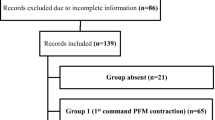Abstract
The aim of this study was to assess pelvic floor muscle (PFM) strength and perception and its correlation with stress urinary incontinence (SUI). One hundred and one women were divided into two groups according to the presence (G1=51 patients) or absence (G2=50 patients) of SUI. Subjective [urine stream interruption test (UST), visual survey of perineal contraction and transvaginal digital palpation to assess pelvic muscle contraction] and objective evaluations of pelvic floor muscles in all patients were performed (vaginal manometry). During the UST, 25.5% of G1 patients and 80% of G2 patients were able to interrupt the urine stream (p<0.05). Digital evaluation of pelvic muscular contraction showed higher strength in G2 than in G1 patients (p<0.0001). Perineometer evaluation of PFM strength was significantly higher in the continent group (p<0.001). Pelvic floor muscle weakness in incontinent patients demonstrates the importance of functional and objective evaluation of this group of muscles.


Similar content being viewed by others
References
Gosling JA, Dixon JS, Critchley HOD (1981) A comparative study of the human external sphincter and periurethral levator ani muscles. Br J Urol 53:35–41
Delancey JOL (1988) Structural aspects of the extrinsic continence mechanism. Obstet Gynecol 72:296–301
Zacharin RF (1980) Pulsion enterocele: review of functional anatomy of the pelvic floor. Obstet Gynecol 55:135–140
Bressler H, Shuessler B (2003) Childbirth-induced trauma to the urethral continence mechanism: review and recommendations. Urology 62:39–44
Amaro JL, Gameiro MOO, Padovani CR (2003) Treatment of urinary stress incontinence by intravaginal electrical stimulation and pelvic floor physiotherapy. Int Urogynecol J Pelvic Floor Dysfunct 14:204–208
Bo K (2003) Pelvic floor muscle strength and response to pelvic muscle training for stress urinary incontinence. Neurourol Urodyn 22:654–658
Satore A, Pregazzi R, Bartoli P, Grimaldi E, Ricci G, Gurschino S (2002) The urine stream interruption test and pelvic muscle function in the puerperium. Int J Gynecol Obstet 78:235–239
Kegel AH (1948) Progressive resistance exercise in the functional restoration of the muscles. Am J Obstet Gynecol 56:238–249
Morkved S, Salvesen KA, Bo K, Eik-Nes S (2004) Pelvic floor muscle strength and thickness in continent and incontinent nulliparous pregnant women. Int Urogynecol J Pelvic Floor Dysfunct 15:384–390
Deveuse A, Staes F, De Weerdt W, Feys H, Van Assche A, Penninckx F, Vereecken R (2004) Clinical evaluation of pelvic floor muscle function in continent and incontinent women. Neurourol Urodyn 23:190–197
Lynch CM, Aronoff CK (2003) Reproducibility of grading scales of pelvic muscle strength: standard versus tampon scale. Int Urogynecol J Pelvic Floor Dysfunct 14:288–290
Goodman LA (1965) On simultaneous confidence intervals for multinomial proportions. Technometrics 7:247–254
Norman GR, Streiner DL (1994) Biostatistics—the bare essentials. Mosby Year Book, St Louis, p 260
Sampelle CM, Delancey JOL (1992) The urine stream interruption test and pelvic muscle function. Nurs Res 41:73–77
Bo K, Finckenhagen B (2003) Is these any difference in measurement of pelvic floor muscle strength in supine and standing position? Acta Obstet Gynecol Scand 82:1120–1125
Bo K, Kibrstein B, Hagen R, Larsen S (1990) Pelvic floor muscle exercise for the treatment of female stress urinary incontinence. II. Validity of vaginal pressure measurements of pelvic floor muscle strength and the necessity of supplementary methods for control of correct contraction. Neurourol Urodyn 9:479–487
Author information
Authors and Affiliations
Corresponding author
Rights and permissions
About this article
Cite this article
Amaro, J.L., Moreira, E.C.H., Gameiro, M.O. et al. Pelvic floor muscle evaluation in incontinent patients. Int Urogynecol J 16, 352–354 (2005). https://doi.org/10.1007/s00192-004-1256-3
Received:
Accepted:
Published:
Issue Date:
DOI: https://doi.org/10.1007/s00192-004-1256-3




